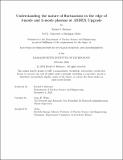| dc.description.abstract | Changes in turbulence at the plasma edge are thought to lead to the formation of the edge transport barrier in tokamak plasmas, which defines the transition from low confinement (L-mode) to high confinement operation such as H-mode or the "improved'' confinement regime I-mode. I-mode is of particular interest for future reactor operation because its unique transport barrier in heat but not particles prevents impurity accumulation and keeps the I-mode edge away from instability boundaries which lead to damaging Edge-Localized Modes. The mechanism for the formation of the edge transport barrier is an open question across high confinement regimes. The unique transport barrier formed in I-mode, with separated heat and particle transport channels, must be understood. This thesis explores fluctuations in the edge region of plasmas at ASDEX Upgrade (AUG) to better understand how changes in fluctuations relate to changes in transport between L and I-mode, as well as L-modes across different magnetic configurations (favorable and unfavorable grad B drift). An extensive turbulence diagnostic suite at AUG is used for experimental exploration of edge turbulence, with special focus on measurements of radiated temperature fluctuations from the Correlation Electron Cyclotron Emission diagnostic.
Comparative studies of L-mode and I-mode edge turbulence reveal that the Weakly Coherent Mode (WCM), previously considered a marker of I-mode, is present in both regimes. The WCM is present across a wide parameter space of collisionality in both L-mode and I-mode. The presence of the WCM and its electron temperature fluctuation amplitude are not correlated with the quality of the global confinement. Properties of the WCM are compared in detail between L and I-mode, with a focus on unfavorable grad B drift plasmas. While some properties of the WCM are consistent between L and I-mode, such as its wavenumbers and radial location, other WCM properties change between the confinement regimes, such as its coupling to a low frequency edge oscillation. Additionally, studies of matched L-modes in favorable and unfavorable grad B drift magnetic configurations show that the WCM can form in L-modes of both magnetic configurations, and that its onset can occur even at power levels far below the L to I-mode and L to H-mode transition. While the nature of fluctuations in the edge of the matched plasmas is seen to be dominated by a WCM-like feature in both the favorable and unfavorable configurations, differences in turbulence damping from velocity shear and the resulting differences in turbulence fluctuation amplitude seem to play into the different H-mode power threshold between the configurations. In addition to these experimental studies, gyrokinetic studies of the L-mode and I-mode are performed at radial locations inside the transport barrier region, with a focus on the outer core. These gyrokinetic studies reveal that the nature of L-mode and I-mode turbulence is very similar in the outer core in terms of the identities of instabilities present, and the response of turbulent heat flux to changes in gradient drives. The fluctuations associated with the I-mode WCM are not inconsistent with the edge transport required for the unique I-mode transport barrier in heat and not particles, however, the presence of the WCM in L-mode shows that this fluctuation is not a unique marker of I-mode. These findings improve our understanding of I-mode phenomenology overall, which is important for its extrapolation to future reactors. | |
